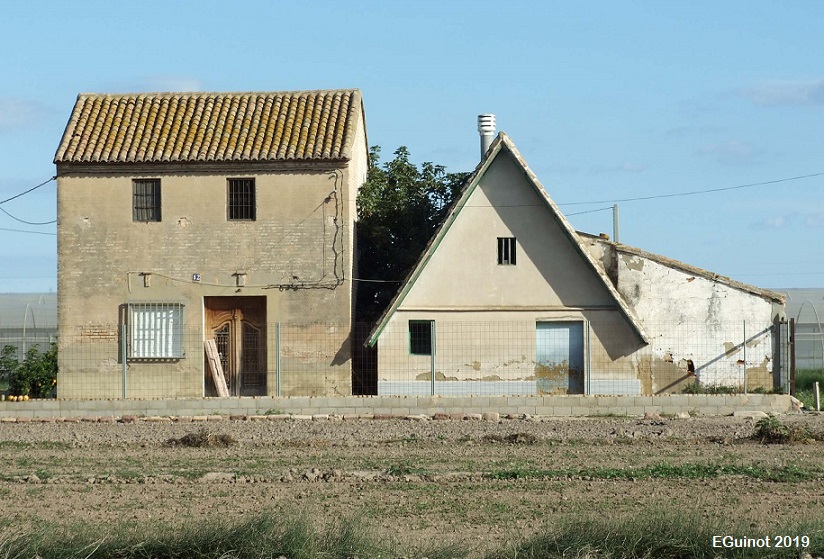
Early twentieth century
According to the Territorial Action Plan of l’Horta (the irrigated land) of València of 2018, the ensemble of barraca (hut) and Casa Blanco dates from the beginning of the 20th century, but J. A. Garcia Esparza, in his catalogue of alqueries (farmhouses) of l’Horta of València gives them an age of 150-200 years. In reality, and as in the case of many other popular constructions in l’Horta of València, it is not at all easy to give an individual chronology and history. Due to their simple constructive structure, they can usually be dated back to the second half of the 19th century or the beginning of the 20th century, even with possible important modifications at some point due to the need for reconstruction. These barraques (huts) do not usually appear in the documents of previous centuries in an identifiable form by names or place names, while at an oral level they were usually known in their surroundings by the name or nickname of the people who owned or lived there. For this reason, the name of the barraca may have been modified as a result of the change of residence of the people who owned or lived there.
According to the Catalogue of Protected Assets and Areas of Rural Nature of the Simplified Revision of the València General Urban Development Plan (2013), the ensemble includes a house with a single corridor and a gabled roof with curved tiles, plus the hut with a porch attached perpendicular to the structure. The house is possibly a replacement for an old barraca (hut), or an extension of the original one, now in a very modern period. The house and the barraca are connected by a hallway, which is eliminated as the two buildings are directly attached to each other, minus the easement of scale. The barraca is seven metres wide and 11 metres (36ft 1 in) long, which means that it is within the parameters of the dimensional canons. It maintains the openings in the façade and the impost line but has replaced the green roof with a fibre cement roof. Although the state of preservation of the hut, the house and the porch are reasonable, it is in a recoverable state.
- Revisió Simplificada Del Pla General De València - Catàleg de béns i espais protegits de Naturalesa Rural (2013) - EPA_SNU_10.14.
- Pla d’Acció Territorial de l’Horta de València. Catàleg de béns i espais protegits de l’Horta de València (2018) - EPA_19.04.
- Direcció General de Patrimoni Cultural Valencià. Catàleg de patrimoni.
GARCIA ESPARZA, J. A. (2012), Barracas del litoral Mediterráneo: catálogo de Valencia y su entorno, Castelló, Universitat Jaume I, pp. 160-161.
DEL REY. M. (2010), Arquitectura Rural Valenciana, Barcelona, Galerada (1ª edició: València, Direcció General de Patrimoni Artístic, 1996)
GARCIA ESPARZA, J. A. (2008), “La barraca Valenciana, procesos de transformación”, Revista valenciana d'etnologia, 3, pp. 145-159.
CRUZ OROZCO, J. (2003), “Las viviendas de cubierta vegetal en el territorio valenciano: el caso de la barraca”, Revista El Pajar: Cuaderno de Etnografía Canaria, 14, pp. 111-116.
RUIZ RUBIO, J. V. (1999), Construint una barraca valenciana, València, Ajuntament d’Alboraia-Col·legi d’Aparelladors i Arquitectes Tècnics de València-Col·legi d’Arquitectes de la Comunitat Valenciana.
SANCHIS GUARNER, M. (1957), Les barraques valencianes, Barcelona, Ed. Barcino. (reedició: València, Institució Alfons el Magnànim, 1999).
ALMELA VIVES, F. (1960), La vivienda rural valenciana, Valencia, La Semana Gráfica.
CASAS TORRES, J. M. (1944), La vivienda y los núcleos rurales de la huerta de Valencia, València, Diputació Provincial de València.
Photos: E. Guinot



















